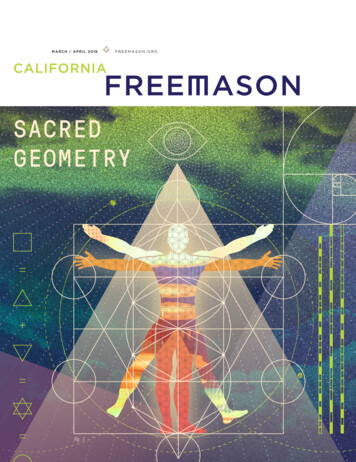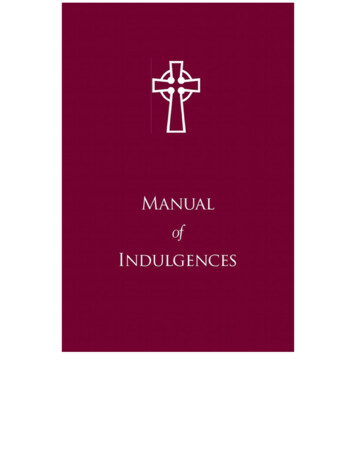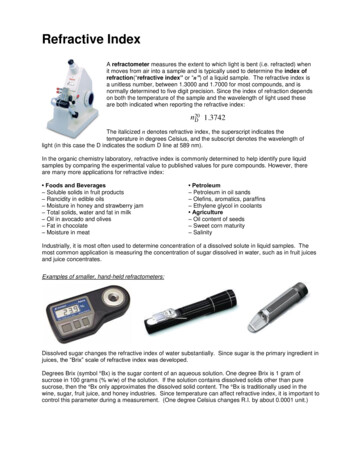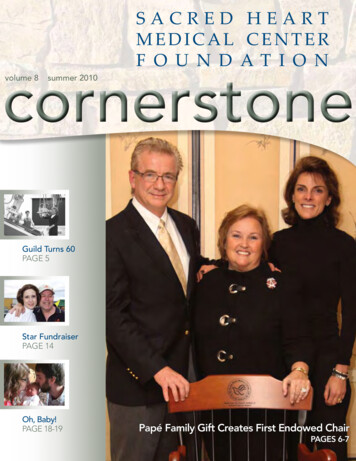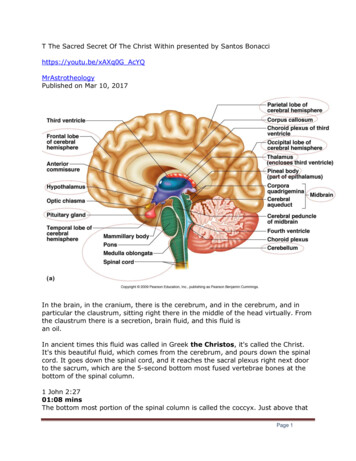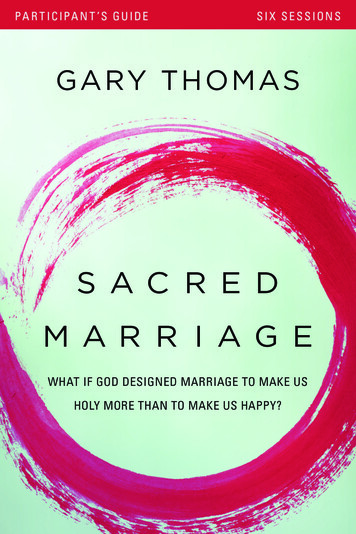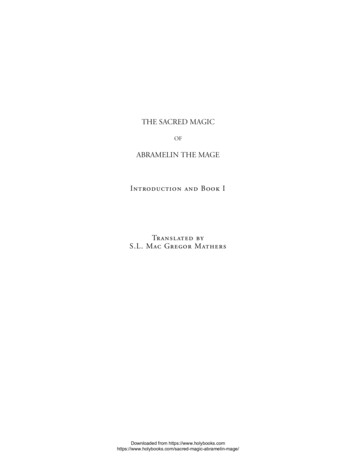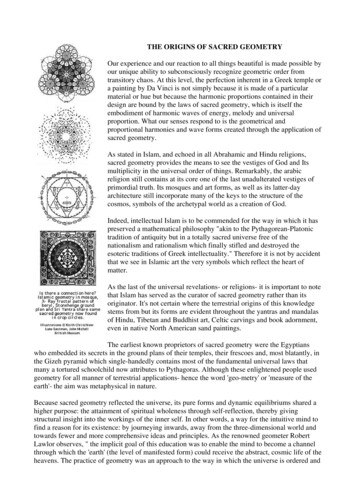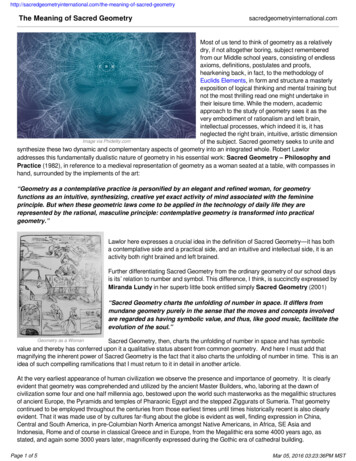
Transcription
The Poetic Edda IndexTHE POETIC EDDAtranslated by HENRY ADAMS BELLOWS[1936]This text is in the public domain because it was not renewed in a timely fashion as requrired at the time by copyright law.(U.S. Copyright Office online records)Start Reading List of FilesMany of the texts at sacred-texts are of interest only to the specialist, somewhat like small art movies. Bycontrast The Poetic Eddas, the oral literature of Iceland which were finally written down from 1000-1300A.D, are like big summer movies, full of gore, sex, revenge and apocalyptic violence.This translation of the Poetic Eddas is highly readable. They are also a primary source for our knowledgeof ancient Norse paganism.The poems are great tragic literature, with vivid descriptions of the emotional states of the protagonists,Gods and heroes alike. Women play a prominent role in the Eddic age, and many of them are delineatedas skilled warriors.The impact of these sagas from a sparsely inhabited rocky island in the middle of the Atlantic on worldculture is wide-ranging. Wagners' operas are largely based on incidents from the Edda, via theNiebelungenlied. J.R.R. Tolkien also plundered the Eddas for atmosphere, plot material and the names ofmany characters in the Hobbit, and the Lord of the Rings. -- jbhTitle PageContentsGeneral skvithaAlvissmolBaldrs DraumarRigsthulaHyndluljothfile:///C /WINDOWS/Desktop/sacred-texts/neu/poe/index.htm (1 of 2) [4/8/2002 10:06:26 PM]
The Poetic Edda IndexSvipdagsmolVölundarkvithaHelgakvitha HjorvarthssonarHelgakvitha Hundingsbana IHelgakvitha Hundingsbana IIFra Dautha ot Af SigurtharkvithuGuthrunarkvitha ISigurtharkvitha En SkammaHelreith BrynhildarDrap NiflungaGuthrunarkvitha II, En FornaGuthrunarkvitha IIIOddrunargratrAtlakvitha En GrönlenzkaAtlamol En GrönlenzkuGuthrunarhvotHamthesmolPronouncing Index Of Proper Namesfile:///C /WINDOWS/Desktop/sacred-texts/neu/poe/index.htm (2 of 2) [4/8/2002 10:06:26 PM]
Title PageIndex NextTHE POETIC EDDATRANSLATED FROM THE ICELANDIC WITH AN INTRODUCTION AND NOTESBYHENRY ADAMS BELLOWSTWO VOLUMES IN ONE1936PRINCETON UNIVERSITY PRESS: PRINCETONAMERICAN SCANDINAVIAN FOUNDATIONNEW YORK{scanned at sacred-texts.com, April-July 2001}{Note: I have indicated the 'caesura' (the break in the middle of the line) throughout this text by the vertical bar character' '--jbh}Next: Contentsfile:///C /WINDOWS/Desktop/sacred-texts/neu/poe/poe00.htm [4/8/2002 10:06:31 PM]
ContentsIndex Previous NextCONTENTS[*]General IntroductionxiLays of the nna151Thrymskvitha174Alvissmol183Baldrs Lays of the HeroesVölundarkvitha252Helgakvitha Hjorvarthssonar269Helgakvitha Hundingsbana I290file:///C /WINDOWS/Desktop/sacred-texts/neu/poe/poe01.htm (1 of 3) [4/8/2002 10:06:34 PM]
ContentsHelgakvitha Hundingsbana II309Fra Dautha Sinfjotla332Gripisspo337Reginsmol356[* For the phonetic spellings of the proper names see the igrdrifumol386Brot af Sigurtharkvithu402Guthrunarkvitha I411Sigurtharkvitha en Skamma420Helreith Brynhildar442Drap Niflunga447Guthrunarkvitha II, en Forna450Guthrunarkvitha III465Oddrunargratr469Atlakvitha en Grönlenzka480Atlamol en /C /WINDOWS/Desktop/sacred-texts/neu/poe/poe01.htm (2 of 3) [4/8/2002 10:06:34 PM]
ContentsACKNOWLEDGEMENTThe General Introduction mentions many of the scholars to whose work this translation owes a specialdebt. Particular reference, however, should here be made to the late William Henry Schofield, Professorof Comparative Literature in Harvard University and President of The American-ScandinavianFoundation, under whose guidance this translation was begun; to Henry Goddard Leach, for many yearsSecretary of The American-Scandinavian Foundation, and to William Witherle Lawrence, Professor ofEnglish in Columbia University and Chairman of the Foundation's Committee on Publications, for theirassistance with the manuscript and the proofs; and to Hanna Astrup Larsen, the Foundation's literarysecretary, for her efficient management of the complex details of publication.{p. xi}Next: General Introductionfile:///C /WINDOWS/Desktop/sacred-texts/neu/poe/poe01.htm (3 of 3) [4/8/2002 10:06:34 PM]
General IntroductionIndex Previous NextGENERAL INTRODUCTIONTHERE is scarcely any literary work of great importance which has been less readily available for thegeneral reader, or even for the serious student of literature, than the Poetic Edda. Translations have beenfar from numerous, and only in Germany has the complete work of translation been done in the full lightof recent scholarship. In English the only versions were long the conspicuously inadequate one made byThorpe, and published about half a century ago, and the unsatisfactory prose translations in Vigfussonand Powell's Corpus Poeticum Boreale, reprinted in the Norrœna collection. An excellent translation ofthe poems dealing with the gods, in verse and with critical and explanatory notes, made by Olive Bray,was, however, published by the Viking Club of London in 1908. In French there exist only partialtranslations, chief among them being those made by Bergmann many years ago. Among the seven oreight German versions, those by the Brothers Grimm and by Karl Simrock, which had considerablehistorical importance because of their influence on nineteenth century German literature and art, andparticularly on the work of Richard Wagner, have been largely superseded by Hugo Gering's admirabletranslation, published in 1892, and by the recent two volume rendering by Genzmer, with excellent notesby Andreas Heusler, 194-1920. There are competent translations in both Norwegian and Swedish. Thelack of any complete and adequately annotated English rendering in metrical form, based on a criticaltext, and profiting by the cumulative labors of such scholars as Mogk, Vigfusson,{p. xii}Finnur Jonsson, Grundtvig, Bugge, Gislason, Hildebrand, Lüning, Sweet, Niedner, Ettmüller,Müllenhoff, Edzardi, B. M. Olsen, Sievers, Sijmons, Detter, Heinzel, Falk, Neckel, Heusler, and Gering,has kept this extraordinary work practically out of the reach of those who have had neither time norinclination to master the intricacies of the original Old Norse.On the importance of the material contained in the Poetic Edda it is here needless to dwell at any length.We have inherited the Germanic traditions in our very speech, and the Poetic Edda is the originalstorehouse of Germanic mythology. It is, indeed, in many ways the greatest literary monument preservedto us out of the antiquity of the kindred races which we call Germanic. Moreover, it has a literary valuealtogether apart from its historical significance. The mythological poems include, in the Voluspo, one ofthe vastest conceptions of the creation and ultimate destruction of the world ever crystallized in literaryform; in parts of the Hovamol, a collection of wise counsels that can bear comparison with most of theBiblical Book of Proverbs; in the Lokasenna, a comedy none the less full of vivid characterizationbecause its humor is often broad; and in the Thrymskvitha, one of the finest ballads in the world. Thehero poems give us, in its oldest and most vivid extant form, the story of Sigurth, Brynhild, and Atli, theNorse parallel to the German Nibelungenlied. The Poetic Edda is not only of great interest to the studentof antiquity; it is a collection including some of the most remark able poems which have been preservedto us from the period before the pen and the printing-press. replaced the poet-singer and oral tradition. Itis above all else the desire{p. xiii}file:///C /WINDOWS/Desktop/sacred-texts/neu/poe/poe02.htm (1 of 9) [4/8/2002 10:06:37 PM]
General Introductionto make better known the dramatic force, the vivid and often tremendous imagery, and the superbconceptions embodied in these poems which has called forth the present translation.WHAT IS THE POETIC EDDA?Even if the poems of the so-called Edda were not so significant and intrinsically so valuable, the longseries of scholarly struggles which have been going on over them for the better part of three centurieswould in itself give them a peculiar interest. Their history is strangely mysterious. We do not know whocomposed them, or when or where they were composed; we are by no means sure who collected them orwhen he did so; finally, we are not absolutely certain as to what an "Edda" is, and the best guess at themeaning of the word renders its application to this collection of poems more or less misleading.A brief review of the chief facts in the history of the Poetic Edda will explain why this uncertainty haspersisted. Preserved in various manuscripts of the thirteenth and early fourteenth centuries is a prosework consisting of a very extensive collection of mythological stories, an explanation of the importantfigures and tropes of Norse poetic diction,--the poetry of the Icelandic and Norwegian skalds wasappallingly complex in this respect,--and a treatise on metrics. This work, clearly a handbook for poets,was commonly known as the "Edda" of Snorri Sturluson, for at the head of the copy of it in theUppsalabok, a manuscript written presumably some fifty or sixty years after Snorri's death, which was in1241, we find: "This book is called Edda, which Snorri Sturluson composed." This work, well known asthe Prose Edda, Snorri's Edda or the{p. xiv}Younger Edda, has recently been made available to readers of English in the admirable translation byArthur G. Brodeur, published by the American-Scandinavian Foundation in 1916.Icelandic tradition, however, persisted in ascribing either this Edda or one resembling it to Snorri's muchearlier compatriot, Sæmund the Wise (1056-1133). When, early in the seventeenth century, the learnedArngrimur Jonsson proved to everyone's satisfaction that Snorri and nobody else must have beenresponsible for the work in question, the next thing to determine was what, if anything, Sæmund haddone of the same kind. The nature of Snorri's book gave a clue. In the mythological stories related anumber of poems were quoted, and as these and other poems were to all appearances Snorri's chiefsources of information, it was assumed that Sæmund must have written or compiled a verseEdda--whatever an "Edda" might be--on which Snorri's work was largely based.So matters stood when, in 1643, Brynjolfur Sveinsson, Bishop of Skalholt, discovered a manuscript,clearly written as early as 1300, containing twenty-nine poems, complete or fragmentary, and some ofthem with the very lines and stanzas used by Snorri. Great was the joy of the scholars, for here, of course,must be at least a part of the long-sought Edda of Sæmund the Wise. Thus the good bishop promptlylabeled his find, and as Sæmund's Edda, the Elder Edda or the Poetic Edda it has been known to thisday.This precious manuscript, now in the Royal Library in Copenhagen, and known as the Codex Regius(R2365), has been the basis for all published editions of the Eddic poems. A few poems of similarcharacter found elsewhere{p. xv}file:///C /WINDOWS/Desktop/sacred-texts/neu/poe/poe02.htm (2 of 9) [4/8/2002 10:06:37 PM]
General Introductionhave subsequently been added to the collection, until now most editions include, as in this translation, atotal of thirty-four. A shorter manuscript now in the Arnamagnæan collection in Copenhagen (AM748),contains fragmentary or complete versions of six of the poems in the Codex Regius, and one other,Baldrs Draumar, not found in that collection. Four other poems (Rigsthula, Hyndluljoth, Grougaldr andFjolsvinnsmol, the last two here combined under the title of Svipdagsmol), from various manuscripts, soclosely resemble in subject-matter and style the poems in the Codex Regius that they have been includedby most editors in the collection. Finally, Snorri's Edda contains one complete poem, the Grottasongr,which many editors have added to the poetic collection; it is, however, not included in this translation, asan admirable English version of it is available in Mr. Brodeur's rendering of Snorri's work.From all this it is evident that the Poetic Edda, as we now know it, is no definite and plainly limitedwork, but rather a more or less haphazard collection of separate poems, dealing either with Norsemythology or with hero-cycles unrelated to the traditional history of greater Scandinavia or Iceland. Howmany other similar poems, now lost, may have existed in such collections as were current in Iceland inthe later twelfth and thirteenth centuries we cannot know, though it is evident that some poems of thistype are missing. We can say only that thirty-four poems have been preserved, twenty-nine of them in asingle manuscript collection, which differ considerably in subject-matter and style from all the rest ofextant Old Norse poetry, and these we group together as the Poetic Edda.{p. xvi}But what does the word "Edda" mean? Various guesses have been made. An early assumption was thatthe word somehow meant "Poetics," which fitted Snorri's treatise to a nicety, but which, in addition to thelack of philological evidence to support this interpretation, could by no stretch of scholarly subtlety bemade appropriate to the collection of poems. Jacob Grimm ingeniously identified the word with the word"edda" used in one of the poems, the Rigsthula, where, rather conjecturally, it means "great-grandmother." The word exists in this sense no where else in Norse literature, and Grimm's suggestion of"Tales of a Grandmother," though at one time it found wide acceptance, was grotesquely. inappropriateto either the prose or the verse work.At last Eirikr Magnusson hit on what appears the likeliest solution of the puzzle: that "Edda" is simplythe genitive form of the proper name "Oddi." Oddi was a settlement in the southwest of Iceland, certainlythe home of Snorri Sturluson for many years, and, traditionally at least, also the home of Sæmund theWise. That Snorri's work should have been called "The Book of Oddi" is altogether reasonable, for sucha method of naming books was common--witness the "Book of the Flat Island" and other earlymanuscripts. That Sæmund may also have written or compiled another "Oddi-Book" is perfectlypossible, and that tradition should have said he did so is entirely natural.It is, however, an open question whether or not Sæmund had anything to do with making the collection,or any part of it, now known as the Poetic Edda, for of course the seventeenth-century assignment of thework to him is negligible. {p. xvii} We can say only that he may have made some such compilation, forhe was a diligent student of Icelandic tradition and history, and was famed throughout the North for hislearning. But otherwise no trace of his works survives, and as he was educated in Paris, it is probable thathe wrote rather in Latin than in the vernacular.All that is reasonably certain is that by the middle or last of the twelfth century there existed in Icelandone or more written collections of Old Norse mythological and heroic poems, that the Codex Regius, acopy made a hundred years or so later, represents at least a considerable part of one of these, and that thefile:///C /WINDOWS/Desktop/sacred-texts/neu/poe/poe02.htm (3 of 9) [4/8/2002 10:06:37 PM]
General Introductioncollection of thirty-four poems which we now know as the Poetic or Elder Edda is practically all that hascome down to us of Old Norse poetry of this type. Anything more is largely guesswork, and both thename of the compiler and the meaning of the title "Edda" are conjectural.THE ORIGIN OF THE EDDIC POEMSThere is even less agreement about the birthplace, authorship and date of the Eddic poems themselvesthan about the nature of the existing collection. Clearly the poems were the work of many different men,living in different periods; clearly, too, most of them existed in oral tradition for generations before theywere committed to writing. In general, the mythological poems seem strongly marked by pagan sincerity,although efforts have been made to prove them the results of deliberate archaizing; and as Christianitybecame generally accepted throughout the Norse world early in the eleventh century, it seems altogetherlikely that most of the poems dealing{p. xviii}with the gods definitely antedate the year 1000. The earlier terminus is still a matter of dispute. Thegeneral weight of critical opinion, based chiefly on the linguistic evidence presented by Hoffory, FinnurJonsson and others, has indicated that the poems did not assume anything closely analogous to theirpresent forms prior to the ninth century. On the other hand, Magnus Olsen's interpretation of theinscriptions on the Eggjum Stone, which he places as early as the seventh century, have led so competenta scholar as Birger Nerman to say that "we may be warranted in concluding that some of the Eddicpoems may have originated, wholly or partially, in the second part of the seventh century." As for thepoems belonging to the hero cycles, one or two of them appear to be as late as 1100, but most of themprobably date back at least to the century and a half following 900. It is a reasonable guess that the yearsbetween 850 and 1050 saw the majority of the Eddic poems worked into definite shape, but it must beremembered that many changes took place during the long subsequent period of oral transmission, andalso that many of the legends, both mythological and heroic, on which the poems were based certainlyexisted in the Norse regions, and quite possibly in verse form, long before the year 900.As to the origin of the legends on which the poems are based, the whole question, at least so far as thestories of the gods are concerned, is much too complex for discussion here. How much of the actualnarrative material of the mythological lays is properly to be called Scandinavian is a matter for studentsof comparative mythology to{p. xix}guess at. The tales underlying the heroic lays are clearly of foreign origin: the Helgi story comes fromDenmark, and that of Völund from Germany, as also the great mass of traditions centering aroundSigurth (Siegfried), Brynhild, the sons of Gjuki, Atli (Attila), and Jormunrek (Ermanarich). Theintroductory notes to the various poems deal with the more important of these questions of origin. of themen who composed these poems,--'wrote" is obviously the wrong word--we know absolutely nothing,save that some of them must have been literary artists with a high degree of conscious skill. The Eddicpoems are "folk-poetry,"--whatever that may be,--only in the sense that some of them strongly reflectracial feelings and beliefs; they are anything but crude or primitive in workmanship, and they show thatnot only the poets themselves, but also many of their hearers, must have made a careful study of the artof poetry.Where the poems were shaped is equally uncertain. Any date prior to 875 would normally imply anfile:///C /WINDOWS/Desktop/sacred-texts/neu/poe/poe02.htm (4 of 9) [4/8/2002 10:06:37 PM]
General Introductionorigin on the mainland, but the necessarily fluid state of oral tradition made it possible for a poem to be"composed" many times over, and in various and far-separated places, without altogether losing itsidentity. Thus, even if a poem first assumed something approximating its present form in Iceland in thetenth century, it may none the less embody language characteristic of Norway two centuries earlier. Oralpoetry has always had an amazing preservative power over language, and in considering the origins ofsuch poems as these, we must cease thinking in terms of the printing-press, or even in those of the scribe.The{p. xx}claims of Norway as the birthplace of most of the Eddic poems have been extensively advanced, but thegreat literary activity of Iceland after the settlement of the island by Norwegian emigrants late in theninth century makes the theory of an Icelandic home for many of the poems appear plausible. The twoAtli lays, with what authority we do not know, bear in the Codex Regius the superscription "theGreenland poem," and internal evidence suggests that this statement may be correct. Certainly in onepoem, the Rigsthula, and probably in several others, there are marks of Celtic influence. During aconsiderable part of the ninth and tenth centuries, Scandinavians were active in Ireland and in most of thewestern islands inhabited by branches of the Celtic race. Some scholars have, indeed, claimed nearly allthe Eddic poems for these "Western Isles." However, as Iceland early came to be the true cultural centerof this Scandinavian island world, it may be said that the preponderant evidence concerning thedevelopment of the Eddic poems in anything like their present form points in that direction, and certainlyit was in Iceland that they were chiefly preserved.THE EDDA AND OLD NORSE LITERATUREWithin the proper limits of an introduction it would be impossible to give any adequate summary of thehistory and literature with which the Eddic poems are indissolubly connected, but a mere mention of afew of the salient facts may be of some service to those who are unfamiliar with the subject. Old Norseliterature covers approximately the period between 850 and 1300. During the first part of{p. xxi}that period occurred the great wanderings of the Scandinavian peoples, and particularly the Norwegians.A convenient date to remember is that of the sea-fight of Hafrsfjord, 872, when Harald the Fair-Hairedbroke the power of the independent Norwegian nobles, and made himself overlord of nearly all thecountry. Many of the defeated nobles fled overseas, where inviting refuges had been found for them byearlier wanderers and plunder-seeking raiders. This was the time of the inroads of the dreaded Northmenin France, and in 885 Hrolf Gangr (Rollo) laid siege to Paris itself. Many Norwegians went to Ireland,where their compatriots had already built Dublin, and where they remained in control of most of theisland till Brian Boru shattered their power at the battle of Clontarf in 1014.Of all the migrations, however, the most important were those to Iceland. Here grew up an activecivilization, fostered by absolute independence and by remoteness from the wars which wrackedNorway, yet kept from degenerating into provincialism by the roving life of the people, which broughtthem constantly in contact with the culture of the South. Christianity, introduced throughout the Norseworld about the year 1000, brought with it the stability of learning, and the Icelanders became not onlythe makers but also the students and recorders of history. The years between 875 and 1100 were the greatspontaneous period of oral literature. Most of the military and political leaders were also poets, and theyfile:///C /WINDOWS/Desktop/sacred-texts/neu/poe/poe02.htm (5 of 9) [4/8/2002 10:06:37 PM]
General Introductioncomposed a mass of lyric poetry concerning the authorship of which we know a good deal, and much ofwhich has been preserved. Narrative{p. xxii}prose also flourished, for the Icelander had a passion for story-telling and story-hearing. After 1100 camethe day of the writers. These sagamen collected the material that for generations had passed from mouthto mouth, and gave it permanent form in writing. The greatest bulk of what we now have of Old Norseliterature,--and the published part of it makes a formidable library,--originated thus in the earlier periodbefore the introduction of writing, and was put into final shape by the scholars, most of them Icelanders,of the hundred years following 1150.After 1250 came a rapid and tragic decline. Iceland lost its independence, becoming a Norwegianprovince. Later Norway too fell under alien rule, a Swede ascending the Norwegian throne in 1320.Pestilence and famine laid waste the whole North; volcanic disturbances worked havoc in Iceland.Literature did not quite die, but it fell upon evil days; for the vigorous native narratives and heroic poemsof the older period were substituted translations of French romances. The poets wrote mostly doggerel;the prose writers were devoid of national or racial inspiration.The mass of literature thus collected and written down largely between 1150 and 1250 maybe roughlydivided into four groups. The greatest in volume is made up of the sagas: narratives mainly in prose,ranging all the way from authentic history of the Norwegian kings and the early Icelandic settlements tofairy-tales. Embodied in the sagas is found the material composing the second group: the skaldic poetry,a vast collection of songs of praise, triumph, love, lamentation, and so on, almost uniformly characterized{p. xxiii}by an appalling complexity of figurative language. There is no absolute line to be drawn between thepoetry of the skalds and the poems of the Edda, which we may call the third group; but in addition to theremarkable artificiality of style which marks the skaldic poetry, and which is seldom found in the poemsof the Edda, the skalds dealt almost exclusively with their own emotions, whereas the Eddic poems arequite impersonal. Finally, there is the fourth group, made up of didactic works, religious and legaltreatises, and so on, studies which originated chiefly in the later period of learned activity.PRESERVATION OF THE EDDIC POEMSMost of the poems of the Poetic Edda have unquestionably reached us in rather bad shape. During thelong period of oral transmission they suffered all sorts of interpolations, omissions and changes, andsome of them, as they now stand, are a bewildering hodge-podge of little related fragments. To someextent the diligent twelfth century compiler to whom we owe the Codex Regius--Sæmund oranother--was himself doubtless responsible for the patchwork process, often supplemented by narrativeprose notes of his own; but in the days before written records existed, it was easy to lose stanzas andlonger passages from their context, and equally easy to interpolate them where they did not by any meansbelong. Some few of the poems, however, appear to be virtually complete and unified as we now havethem.Under such circumstances it is clear that the establishment of a satisfactory text is a matter of the utmostdifficulty. As the basis for this translation I have used the textfile:///C /WINDOWS/Desktop/sacred-texts/neu/poe/poe02.htm (6 of 9) [4/8/2002 10:06:37 PM]
General Introduction{p. xxiv}prepared by Karl Hildebrand (1876) and revised by Hugo Gering (1904). Textual emendation has,however, been so extensive in every edition of the Edda, and has depended so much on the theories ofthe editor, that I have also made extensive use of many other editions, notably those by Finnur Jonsson,Neckel, Sijmons, and Detter and Heinzel, together with numerous commentaries. The condition of thetext in both the principal codices is such that no great reliance can be placed on the accuracy of thecopyists, and frequently two editions will differ fundamentally as to their readings of a given passage oreven of an entire-poem. For this reason, and because guesswork necessarily plays so large a part in anyedition or translation of the Eddic poems, I have risked overloading the pages with textual notes in orderto show, as nearly as possible, the exact state of the original together with all the more significantemendations. I have done this particularly in the case of transpositions, many of which appear absolutelynecessary, and in the indication of passages which appear to be interpolations.THE VERSE-FORMS OF THE EDDIC POEMSThe many problems connected with the verse-forms found in the Eddic poems have been analyzed ingreat detail by Sievers, Neckel, and others. The three verse-forms exemplified in the poems need only abrief comment here, however, in order to make clear the method used in this translation. All of theseforms group the lines normally in four-line stanzas. In the so-called Fornyrthislag ("Old Verse"), forconvenience sometimes referred to in the notes as four-four measure, these lines have all the same{p. xxv}structure, each line being sharply divided by a cæsural pause into two half-lines, and each half-linehaving two accented syllables and two (sometimes three) unaccented ones. The two half-lines forming acomplete line are bound together by the alliteration, or more properly initial-rhyme, of three (or two) ofthe accented syllables. The following is an example of the Fornyrthislag stanza, the accented syllablesbeing in italics:VreiÞr vas VingÞórr, es vaknaÞiok síns hamars of saknaÞi;skegg nam hrista, skor nam dýja,réÞ JarÞar burr umb at Þreifask.In the second form, the Ljothahattr ("Song Measure"), the first and third line of each stanza are as justdescribed, but the second and fourth are shorter, have no cæsural pause, have three accented syllables,and regularly two initial-rhymed accented syllables, for which reason I have occasionally referred toLjothahattr as four-three measure. The following is an example:Ar skal rísa sás annars villfé eÞa fior hafa;liggjandi ulfr sjaldan láer of getrné sofandi maÞr sigr.In the third and least commonly used form, the Malahattr ("Speech Measure"), a younger verse-form thaneither of the other two, each line of the four-line stanza is divided into two half-lines by a cæsural pause,each half line having two accented syllables and three (sometimesfile:///C /WINDOWS/Desktop/sacred-texts/neu/poe/poe02.htm (7 of 9) [4/8/2002 10:06:37 PM]
General Introduction{p. xxvi}four) unaccented ones; the initial rhyme is as in the Fornyrthislag. The following is an example:Horsk vas húsfreyja, hugÞi at mannviti,lag heyrÞi òrÞa, hvat á laun máeltu;Þá vas vant vitri, vildi Þeim hjalÞa:skyldu of sáe
hero poems give us, in its oldest and most vivid extant form, the story of Sigurth, Brynhild, and Atli, the Norse parallel to the German Nibelungenlied. The Poetic Edda is not only of great interest to the student of antiquity; it is a collection including some of the most rem

